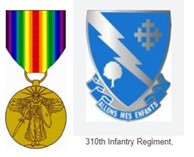Name: Dexter, Charles Spafford, PVT, USA
Local address: 67 Atlantic Ave, Aberdeen, NJ
The Dexter family had been in Matawan since the 1860s, with father Charles, SR, being born here in 1862. He married Matawan girl Mary Catherine Walling (1862-1953) in the borough on January 6, 1884, and they subsequently had four children – Charles, JR, born January 4, 1893, being the third and only son. The father, a carpenter, died at 44 years of age in 1906, leaving his wife and children, who ranged in ages from 20 to 9.
Records regarding Charles’ early years in Matawan are scarce. Younger sister Sarah is known to have been educated in the Matawan school system, so the other children probably were, too. The 1915 New Jersey census indicated he was employed as a railroad brakeman. When he registered for the draft on June 5, 1917 he worked as a railroad fireman for the Central Railroad of New Jersey – at the time he was described as being of medium height and size, with blue eyes and brown hair.
Charles was inducted into the service in Keyport on April 3, 1918, and after training was assigned to Company “L” of the 310th Infantry Regiment, and became a “waggoneer” in that unit’s supply corps. On May 10, 1918, he shipped to France aboard the SS Northland out of Philadelphia. One can imagine his family and friends traveling there to see him off.
His unit was involved in the St. Mihiel offensive, specifically in the Limey Sector of the Meuse-Argonne region in September. The 310th, part of the 78th Division, was attached to the 1st US Army Corps during this engagement, and they advanced to the east of St. Mihiel. The operation was a success for the American forces due to the commander’s detailed planning and successful use of combined arms.
The role of a waggoneer was dangerous – they had to move men and supplies between the rear areas and front trench lines, leaving them exposed and vulnerable to enemy artillery. Charles reportedly encountered many “hairbreadth experiences,” according to newspaper reporting.
The war ended the following November, but the US troops had another threat they had to deal with, the Spanish Influenza epidemic that fall. With the concentration of so many non-immune individuals in close quarters, the conditions for the disease’s spread were optimal. While the epidemic peaked in October and November of 1918, it remained in effect in the camps throughout 1919. Charles may have caught it and died of lobar pneumonia on February 8, 1919 in France. (A notation in his military file, probably by a family member, indicated he was sent to Base Hospital #36 for a “slight operation” in January of 1919, caught a cold which developed into pneumonia and subsequently killed him.)
Initially interred in the American Cemetery in Meucon in Brittany in northwestern France, his body was placed aboard the SS Princess Matoika on September 5, 1920 with many other deceased soldiers. Returned to the Bedle Funeral Home in Keyport, Charles’ funeral was held at Matawan’s First Methodist Church on the 26th, after which he was buried in the family plot in the Green Grove Cemetery in Keyport.


NO COMMENTS